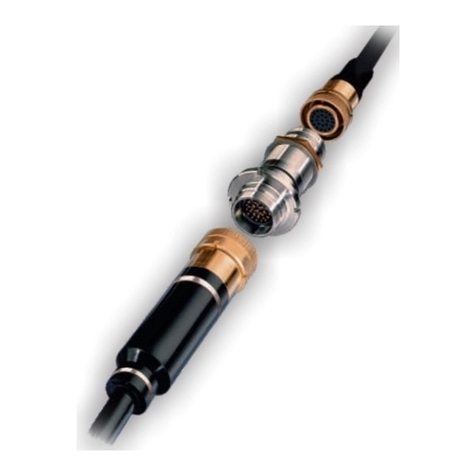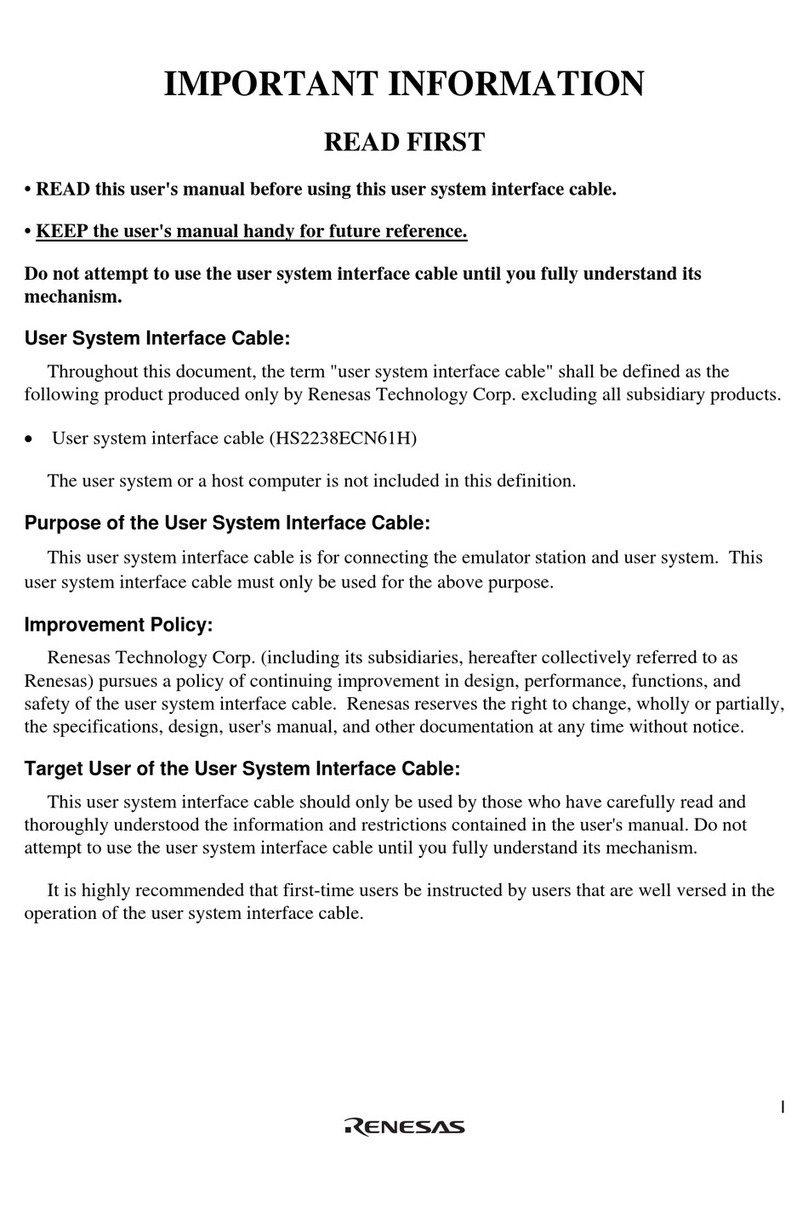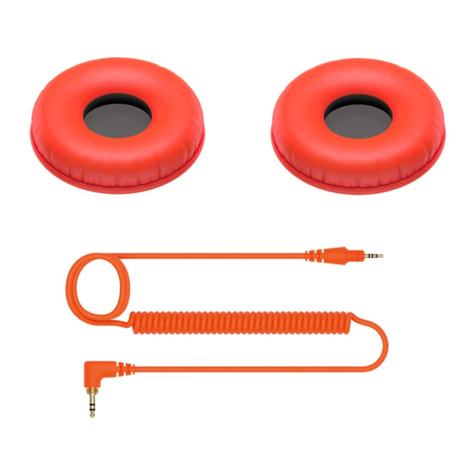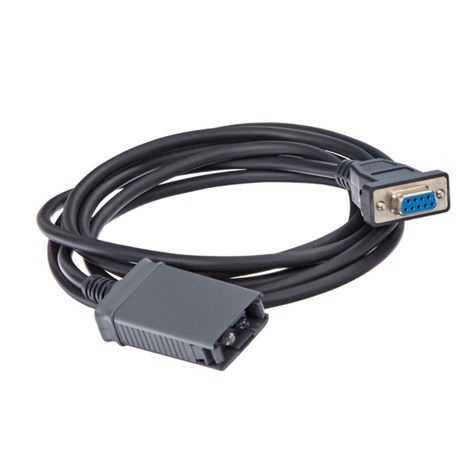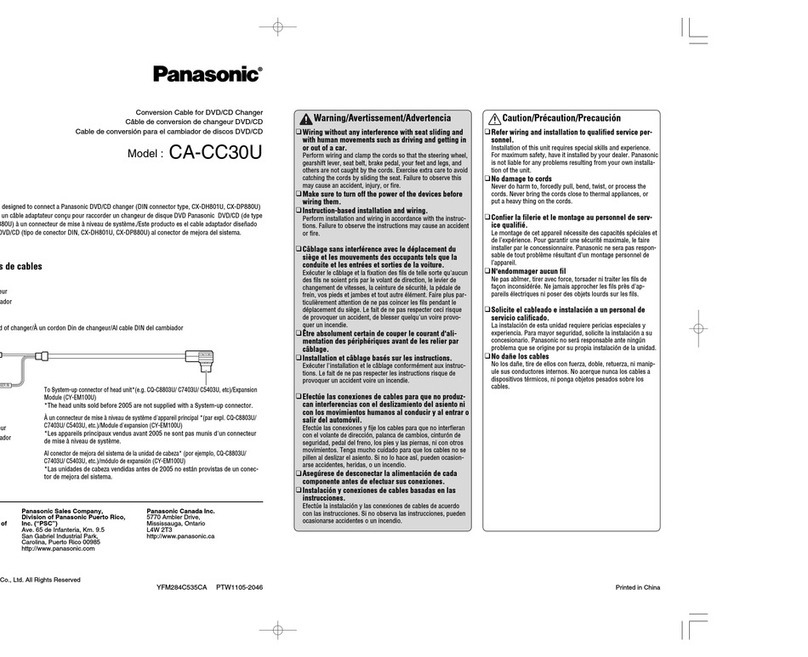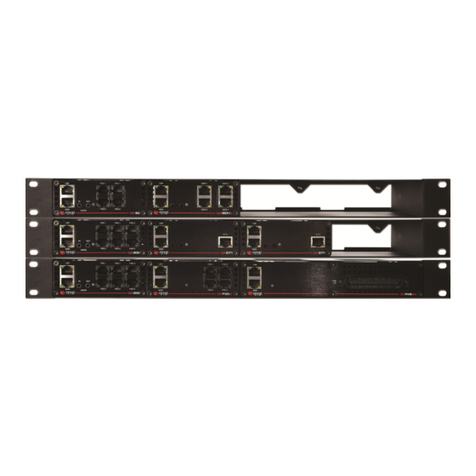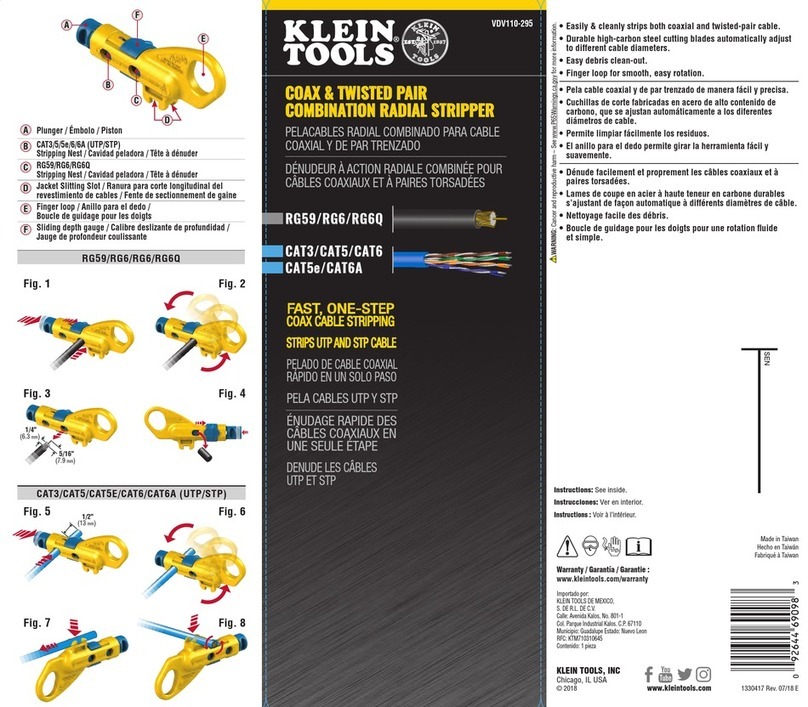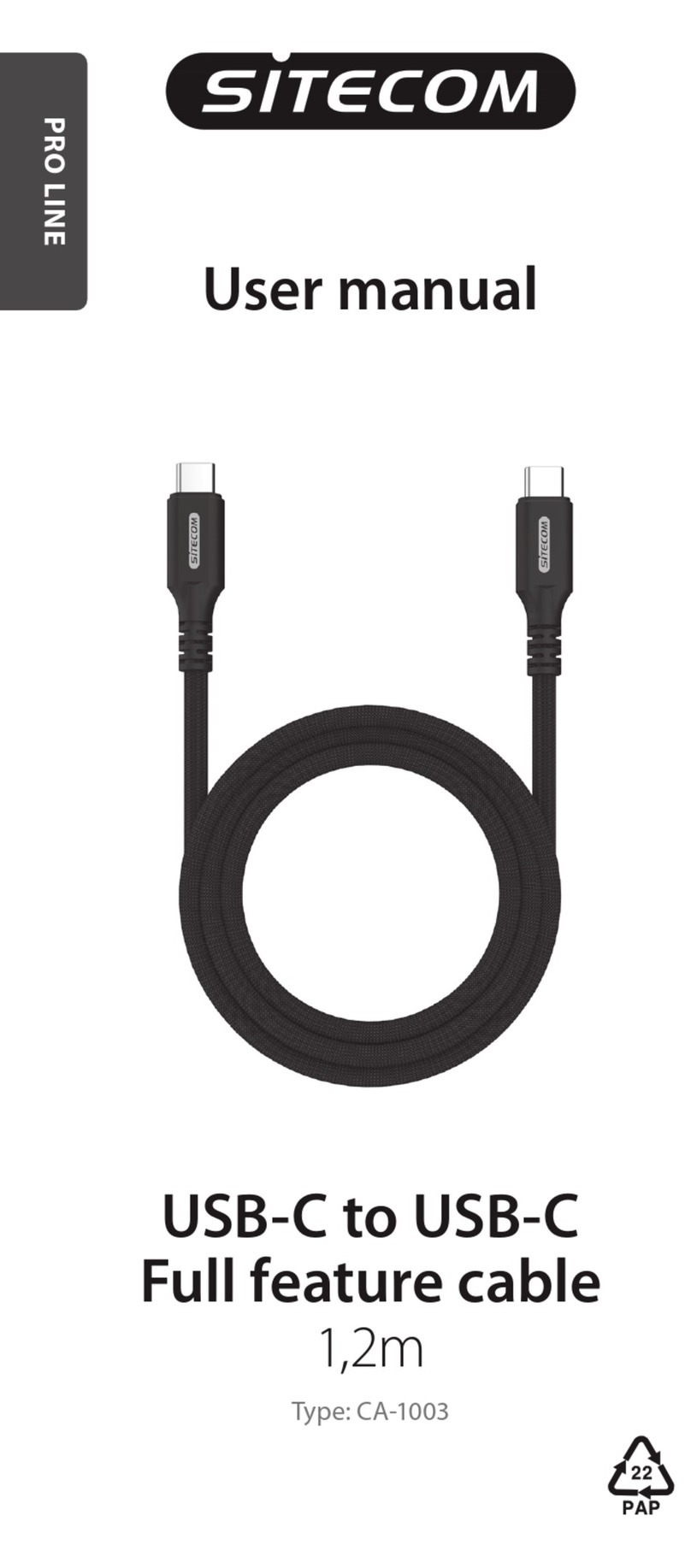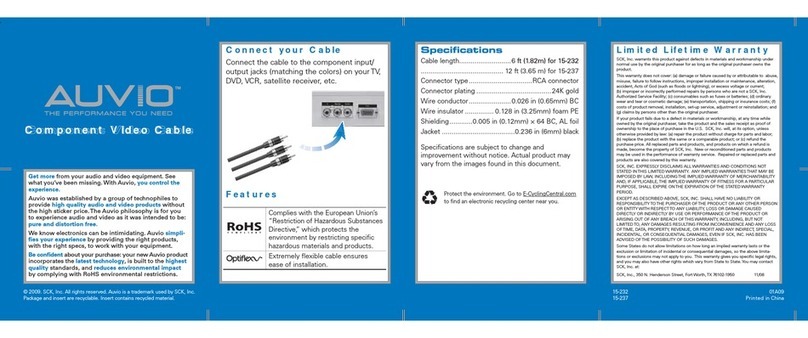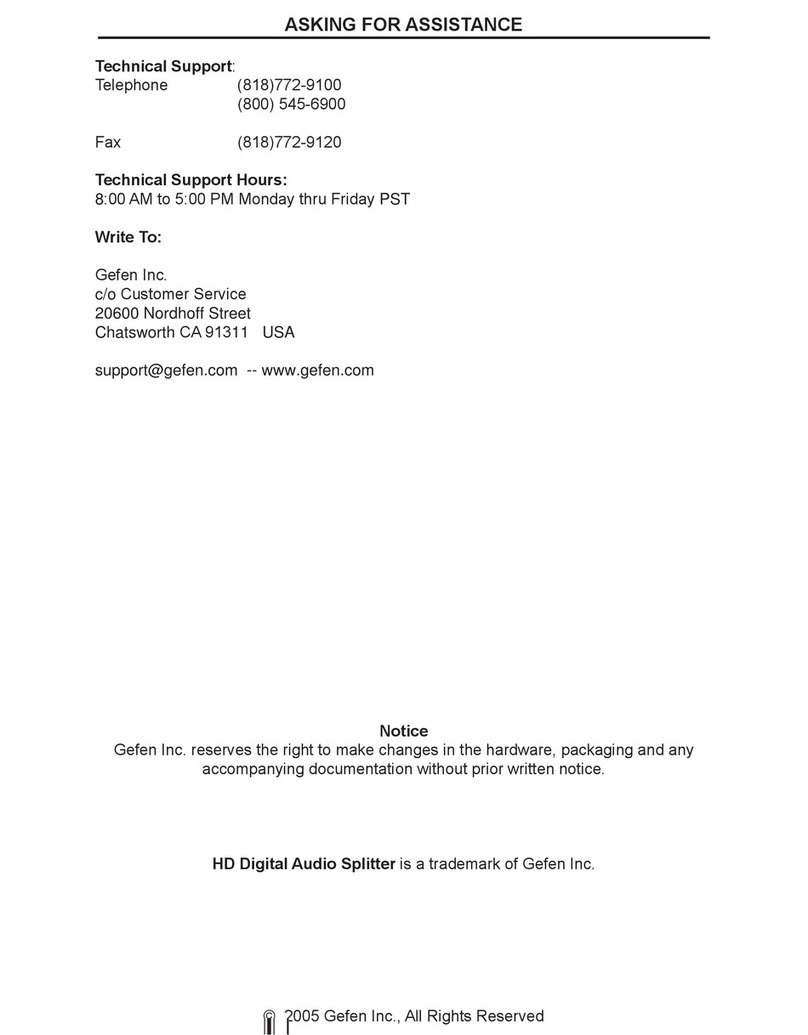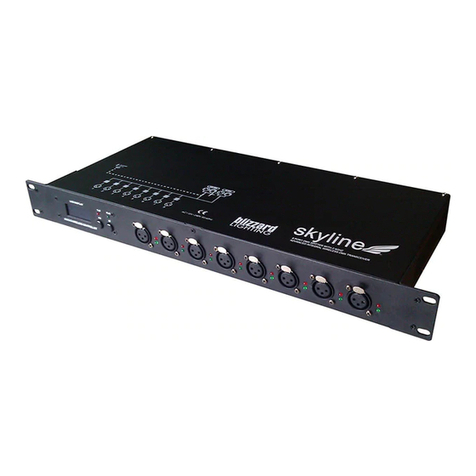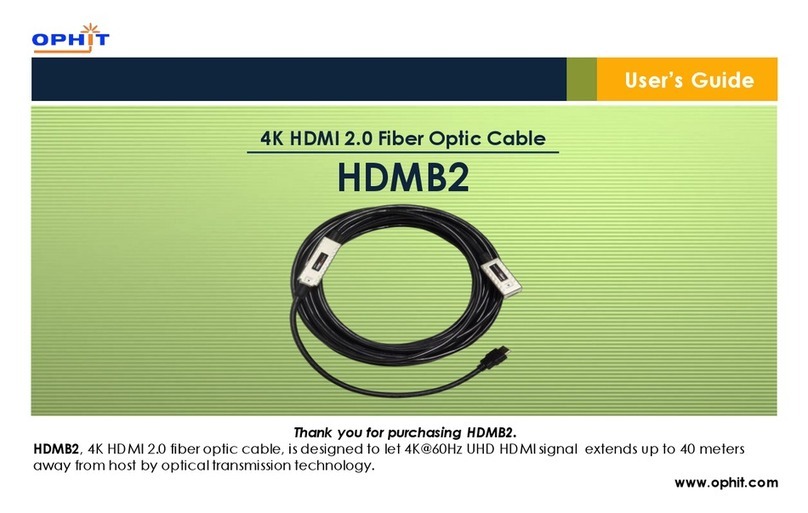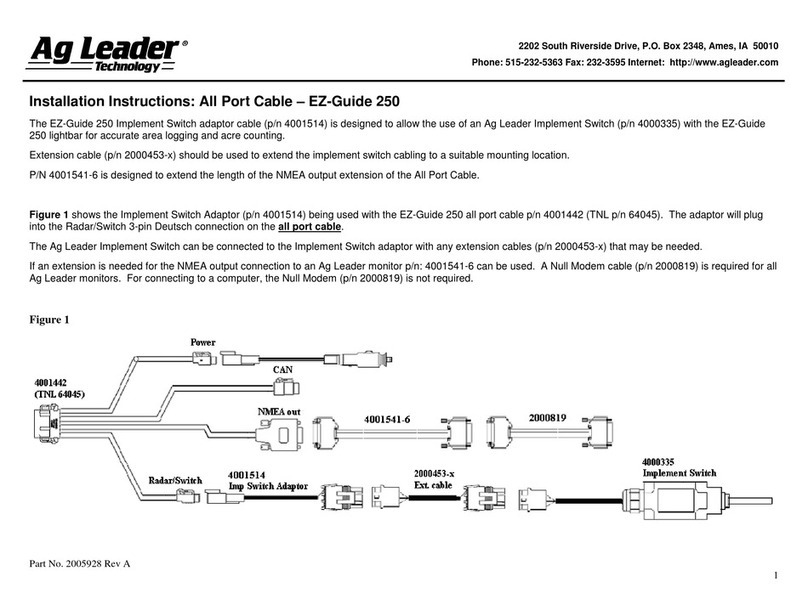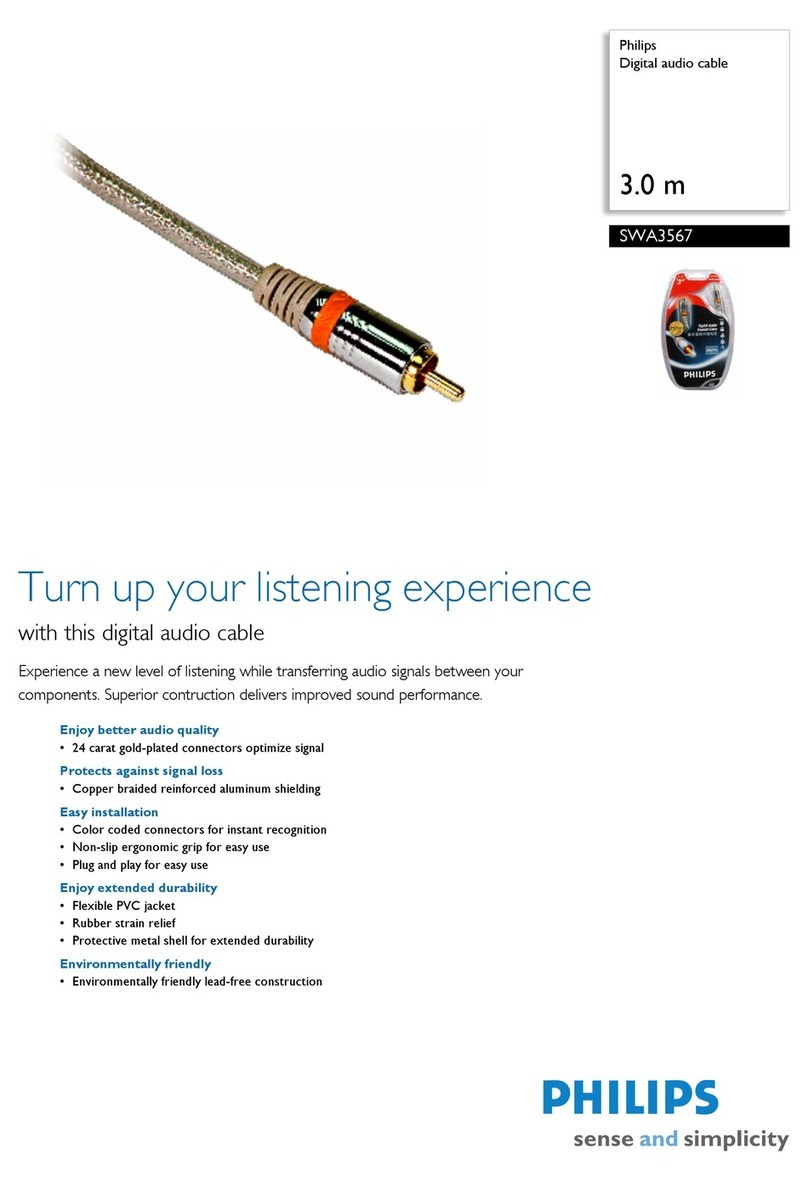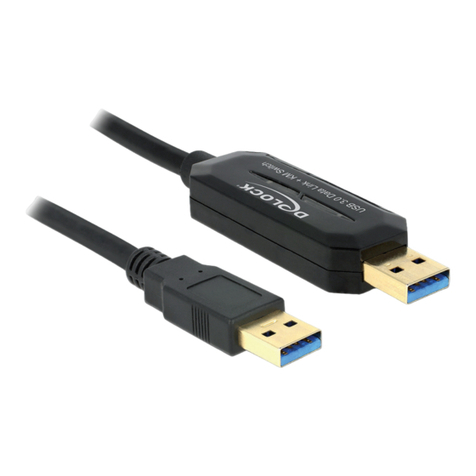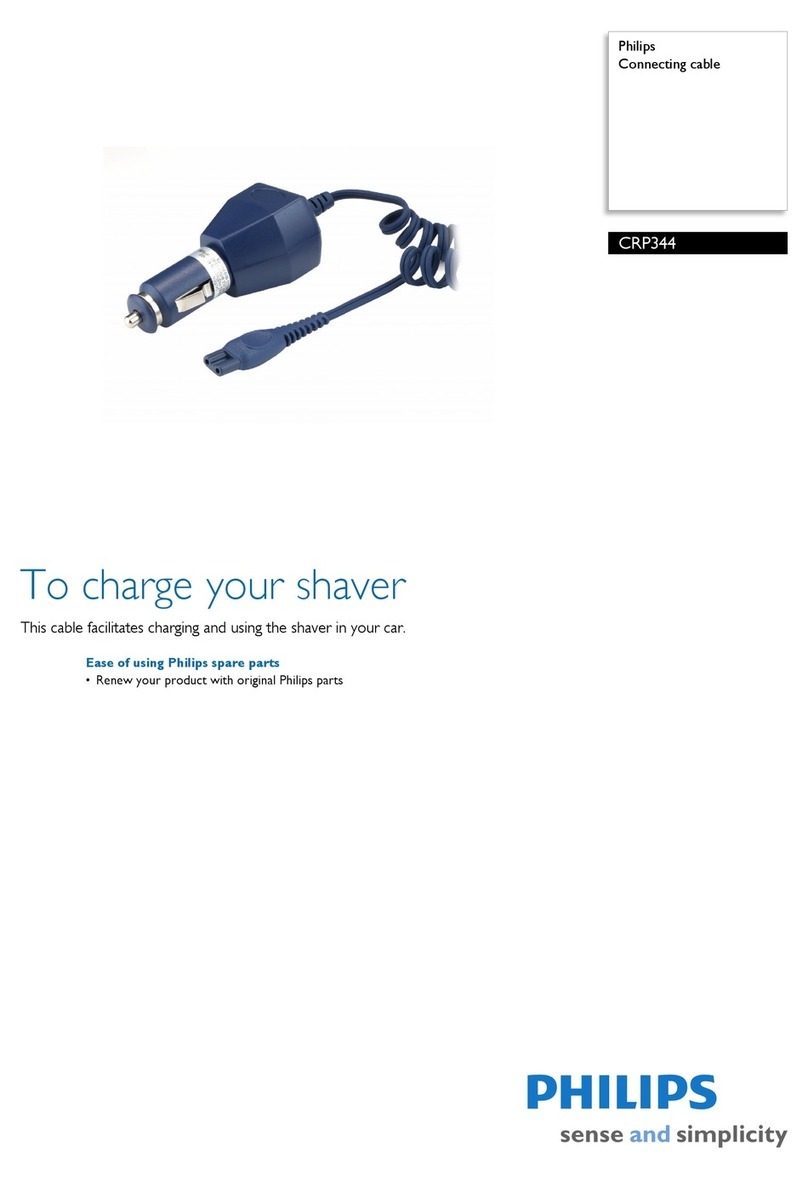GISMA 10 Series User manual


Handling instructions
for GISMA connectors
HI –2007 - 001
Document: replaces
MV 2000-020,
MV 2000-030 and
MV 2005 - 011
First issue: 15.07.2008
Rev.-Index: -Z-
From: 29.07.2020
Copyright by:
GISMA GmbH
Page 2 of 44
Content
1. GENERAL ....................................................................................................................................4
2. SCOPE.........................................................................................................................................4
3. PROTECTION, HANDLING AND SHIPMENT.............................................................................4
4. UNPACKING................................................................................................................................5
5. STORAGE....................................................................................................................................5
Short Term Connector Storage ...........................................................................................5
Long Term Connector Storage............................................................................................5
6. Jumper handling and mounting....................................................................................................5
Jumper handling ..................................................................................................................5
7. DEPLOYMENT & MAINTENANCE..............................................................................................6
SUBSEA CONNECTORS SERIES 10 ................................................................................6
7.1.1. General........................................................................................................................6
7.1.2. Live Mate / Demate......................................................................................................7
7.1.3. Protection of receptacle’s pin contacts ........................................................................7
7.1.4. Removal of Marine Growth and Calcareous Deposits ................................................7
7.1.5. Connector Handling.....................................................................................................8
7.1.6. Mounting dimensions.................................................................................................11
SUBSEA TITANIUM CONNECTORS SERIES 16............................................................12
7.2.1. General......................................................................................................................12
7.2.2. Live Mate / Demate....................................................................................................13
7.2.3. Protection of receptacle’s pin contacts ......................................................................13
7.2.4. Removal of Marine Growth and Calcareous Deposits ..............................................13
7.2.5. Connector Handling...................................................................................................13
7.2.6. Test Port ....................................................................................................................14
7.2.7. Pressure Balanced Oil Filled Hose (PBOF)...............................................................14
SUBSEA CONNECTORS SERIES 22 ..............................................................................16
7.3.1. General......................................................................................................................16
7.3.2. Live Mate / Demate....................................................................................................16
7.3.3. Protection of receptacle’s pin contacts ......................................................................17
7.3.4. Removal of Marine Growth and Calcareous Deposits ..............................................17
7.3.5. Connector Handling...................................................................................................17
7.3.6. Mounting dimension...................................................................................................18
7.3.7. Sealing spare parts....................................................................................................19
SUBSEA CONNECTORS SERIES 34 ..............................................................................23
7.4.1. General......................................................................................................................23
7.4.2. Live Mate / Demate....................................................................................................24
7.4.3. Protection of receptacle’s pin contacts ......................................................................24
7.4.4. Removal of Marine Growth and Calcareous Deposits ..............................................24
7.4.5. Connector Handling...................................................................................................24
SUBSEA CONNECTORS SERIES 35 ..............................................................................26
7.5.1. General......................................................................................................................26
7.5.2. Live Mate / Demate....................................................................................................27
7.5.3. Protection of receptacle’s pin contacts ......................................................................27
7.5.4. Removal of Marine Growth and Calcareous Deposits ..............................................27
7.5.5. Connector Handling...................................................................................................27
SUBSEA CONNECTORS SERIES 40 ..............................................................................29
7.6.1. General......................................................................................................................29
7.6.2. Live Mate / Demate....................................................................................................29
7.6.3. Protection of receptacle’s pin contacts ......................................................................30
7.6.4. Removal of Marine Growth and Calcareous Deposits ..............................................30
7.6.5. Cleaning process for ferrules.....................................................................................31
7.6.6. Connector Handling...................................................................................................31
SUBSEA CONNECTORS SERIES 42 ..............................................................................33

Handling instructions
for GISMA connectors
HI –2007 - 001
Document: replaces
MV 2000-020,
MV 2000-030 and
MV 2005 - 011
First issue: 15.07.2008
Rev.-Index: -Z-
From: 29.07.2020
Copyright by:
GISMA GmbH
Page 3 of 44
7.7.1. General......................................................................................................................33
7.7.2. Live Mate / Demate....................................................................................................33
7.7.3. Protection of receptacle’s pin contacts ......................................................................34
7.7.4. Removal of Marine Growth and Calcareous Deposits ..............................................34
7.7.5. Cleaning process for ferrules.....................................................................................35
7.7.6. Connector Handling...................................................................................................35
SUBSEA CONNECTORS SERIES 80 ..............................................................................37
7.8.1. General......................................................................................................................37
7.8.2. Live Mate / Demate....................................................................................................37
7.8.3. Protection of receptacle contact pins.........................................................................38
7.8.4. Removal of Marine Growth and Calcareous Deposits ..............................................38
7.8.5. Diver Mate Connectors..............................................................................................38
7.8.6. Stab Plate Connectors...............................................................................................40
7.8.7. ROV Connectors........................................................................................................41
7.8.8. Mounting hole for flange-receptacle ..........................................................................43

Handling instructions
for GISMA connectors
HI –2007 - 001
Document: replaces
MV 2000-020,
MV 2000-030 and
MV 2005 - 011
First issue: 15.07.2008
Rev.-Index: -Z-
From: 29.07.2020
Copyright by:
GISMA GmbH
Page 4 of 44
GISMA ELECTRICAL & FIBRE OPTIC CONNECTORS -
PROTECTION, STORAGE, SHIPMENT, UNPACKING,
DEPLOYMENT & MAINTENANCE INSTRUCTIONS
1. GENERAL
Thank you for purchasing a GISMA product. The information that follows is an overview of the
protection, storage, shipment, unpacking, deployment and maintenance instructions for GISMA
electrical and fibre optic products.
GISMA recommend the termination and handling of all equipment only be undertaken by suitably
trained and qualified personnel.
2. SCOPE
This procedure includes information on the following connector types:
GISMA series 10
GISMA series 16
GISMA series 22
GISMA series 34
GISMA series 35
GISMA series 40
GISMA series 42
GISMA series 80
Sections 3, 4, 5 and 6 handle general information applicable to all GISMA connectors. Section 7
then provides specific information relevant to each connector series.
3. PROTECTION, HANDLING AND SHIPMENT
GISMA electrical, fibre and hybrid connectors are manufactured primarily from materials such as
stainless steel 1.4404 / 1.4571 (316L / 316Ti), marine bronze (CW307G) and titanium Grade 5, and
as such are designed to withstand harsh saliferous environments. However, the connector insulator
and exposed parts are susceptible to mechanical damage if not adequately protected. Dust caps are
fitted to all GISMA connectors before transport, but can be fitted with POM protective caps or
pressure watertight protective caps, if specified by the customer. Pressure watertight caps must
remain in place until the connectors are ready for the underwater mating process.
The connectors are generally relatively small items of equipment, and therefore, can be shipped
singularly or in multiples. Care should be taken to protect the connector with bubble wrap or similar
wrapping materials to avoid surface damage during transit. Dust caps or POM protective caps must
be fitted at all times during transport.
If the connectors are assembled onto cables these must be suitably coiled and secured with
appropriate material (tape, cable strap) to prevent uncoiling during transit. Recommended bend
radius for storage/transport of cables, refer to cable specification or jumper drawing.
Any connector-specific handling and transport advice is contained within the appropriate section
further on in this document.

Handling instructions
for GISMA connectors
HI –2007 - 001
Document: replaces
MV 2000-020,
MV 2000-030 and
MV 2005 - 011
First issue: 15.07.2008
Rev.-Index: -Z-
From: 29.07.2020
Copyright by:
GISMA GmbH
Page 5 of 44
4. UNPACKING
Remove wrapping material taking care to inspect for any surface damage or items that may have
become separated from the connector, such as ‘O-ring' seals. Do not use a knife to cut the wrapping
material, as this may cause damage to any elastomeric parts of the connector. Do not remove any
kind of protection caps until connectors are ready for installation. On removal do not allow the cables
to drag over the edges of the packing crate.
5. STORAGE
Short Term Connector Storage
Prior to installation the connectors are sensitive to environments where grit and dirt are present.
To prevent ingress of the above, they should be stored in a clean dry area and be protected by
bubble wrap or similar wrapping and packing material. Protective caps must be fitted if supplied.
Long Term Connector Storage
The connectors must be stored in a clean dry area and be protected by bubble wrap or similar.
Suitable protective caps must be fitted, and the storage temperature should be ideally between
+5°C and +20°C. For short times and during transport storage temperature can be between -40°C
and +70°C. Humidity of the store room should be below 75%. Very moist or very dry conditions
should be avoided. The connectors should be protected from sunlight and artificial light with a
high ultra violet content.
The connectors should not be allowed to come into contact with solvents, oil, greases or any other
semi-solid materials.
If storage time is longer than 2 years, outer o-rings have to be replaced prior to installation.
6. Jumper handling and mounting
Jumper handling
GISMA connectors can be delivered as part of the jumper assembly. All terminated connectors
are delivered with dust caps for protecting the contacts and the insulator against damage and
dust. These caps have to be removed before subsea usage.
Before mounting inspect the jumper and especially the cable for damages and debris.
Lightly grease the locking threads of the receptacles, pressure hull penetrators and the through
bulkhead receptacles e.g. with GISMA-FETT LP 430 (strongly recommended atstainless steel and
titanium threads).
After mounting the cable has to be fixed closed to the structure (first fix point 500 mm behind the
connector’s endbell and then every 500 mm) to prevent movement and turning of the jumper
cable.
Take care that all connectors are correctly mated and locked with the correct mounting torque or
protected by pressure watertight protective caps before going subsea. For defined mounting
instructions refer to the different connector series and special jumper drawings.
Prior to installation the connectors are sensitive to environments where grit and dirt are.

Handling instructions
for GISMA connectors
HI –2007 - 001
Document: replaces
MV 2000-020,
MV 2000-030 and
MV 2005 - 011
First issue: 15.07.2008
Rev.-Index: -Z-
From: 29.07.2020
Copyright by:
GISMA GmbH
Page 6 of 44
7. DEPLOYMENT & MAINTENANCE
The following section details deployment and maintenance instructions for all GISMA connectors &
cables, categorised by product type. Please refer to the appropriate section as listed below:
7.1. - Subsea connectors’series 10
7.2. - Subsea connectors’ series 16
7.3. - Subsea connectors’ series 22
7.4. - Subsea connectors’ series 34
7.5. - Subsea connectors’ series 35
7.6. - Subsea connectors’ series 40
7.7. - Subsea connectors’ series 42
7.8. - Subsea connectors’ series 80
All information contained within this section is generic. Where customer or project-specific
information is required, please refer to the relevant project specification or scope of supply.
For further technical information refer to the catalogues of the different series or special drawings.
Note: It is important to isolate and earth prior to disconnect in order to remove any stray
charges in the system. If left, this can induce corrosion on the exposed pins once the plug is
removed.
The connector shall have the following periodic maintenance checks:
Examine the connector for signs of damage.
Check the locking sleeve, these shall be tight, if loose refer to assembly instruction
for torque values, where appropriate.
SUBSEA CONNECTORS SERIES 10
7.1.1. General
The series 10 sizes 1 to 7 range of connectors has been developed for long term reliable signal
and low power control system applications associated with offshore installations. The underwater
mateability of the range of signal connectors series 10 (contact-Ø 1mm and 1,5mm) is achieved
by using a patented, conical sealing system at each contact and a lip gasket.
For further technical information refer to the catalogue of series 10 or special drawings.
The connector range series 10 comprises standard power connectors for high voltage and high
current application as well. NOTE! These connectors are not underwater pluggable. Please ask
for detailed product information.
Connectors are usually supplied with dust caps. The dust caps need to be removed prior to mating
the connectors.
All mild steel sealing interfaces shall be inlayed with Inconel 625, or similar, where no additional
protection can be provided. This is to prevent localised pitting of the interface. If not possible
grease the mounting hole and the supporting surface with corrosion preventing fluid (for example
Fluid Film) as a minimum.

Handling instructions
for GISMA connectors
HI –2007 - 001
Document: replaces
MV 2000-020,
MV 2000-030 and
MV 2005 - 011
First issue: 15.07.2008
Rev.-Index: -Z-
From: 29.07.2020
Copyright by:
GISMA GmbH
Page 7 of 44
Stainless steel (1.4404/ 1.4571 comparable to 316L/316Ti) or titanium grade 5 stab plate con-
nectors must be connected to the CP (Cathodic Protection) system at all times. If the connector
is designed with a fixed flange and screw mounting, an additional CP connecting would not be
required. Super Duplex stainless steel connectors should be isolated from the CP system to
reduce the possibility of hydrogen embrittlement.
If the connectors are to be left unmated in seawater for any length of time, pressure watertight
protective caps must be used to protect the contacts. Over exposure will increase the risk of
corrosion damage or marine growth on the contact surfaces of the pin contacts. This could lead
to damage to the seals and insulation within the socket contacts.
The appropriate test connector must always be used to make electrical contact during testing.
UNDER NO CIRCUMSTANCES should a foreign object (such as a screwdriver, test probe or
crocodile clip) be used as a test connection as this could damage the seals and insulation. Such
actions will invalidate the warranty of the connector.
Attention: The customer is responsible for the safe operation of the connectors and cable
systems. All necessary protective measures must be taken.
Test connectors or free touchable connectors with metal shell must be connected to the
earth conductor.
The series 10 range of connectors can be supplied either singularly or as part of a harness
assembly. All series 10 connectors require the following acceptance tests during termination:
Mating test
Insulation Resistance test
High Voltage test
Continuity test
Cable terminations can be performed on-site or offshore by GISMA trained personnel where the
cable cannot easily be moved or transported. Each series 10 connector has been mated,
hydrostatically tested (applies to receptacles only) and electrically proven prior to despatch.
Termination of these connectors should only be undertaken by trained personnel.
7.1.2. Live Mate / Demate
The series 10 range of connectors are designed to be mated / de-mated with POWER OFF.
7.1.3. Protection of receptacle’s pin contacts
Under no circumstances the contacts should be exposed to seawater with power on. If this
situation does occur the contact surfaces of the contacts will very rapidly degrade by electrolytic
action. If these damaged pins are subsequently mated into a socket insert there is a very high
risk of damage to the insulation and seals within the plug.
7.1.4. Removal of Marine Growth and Calcareous Deposits
To remove calcite growth topside or subsea from GISMA connectors, a solution of 50% Citric Acid
is recommended. All seawater exposed elastomeric materials in GISMA connectors have been
fully tested against 50% Citric Acid and are compatible for duration of 1 hour. In addition, the
thermoplastic materials have good resistance to Citric Acid.

Handling instructions
for GISMA connectors
HI –2007 - 001
Document: replaces
MV 2000-020,
MV 2000-030 and
MV 2005 - 011
First issue: 15.07.2008
Rev.-Index: -Z-
From: 29.07.2020
Copyright by:
GISMA GmbH
Page 8 of 44
Other acid cleaners, such as >50% Acetic Acid, should not be used as they may cause
deterioration of the elastomeric materials.
Chiselling and abrasive methods are not recommended. Use of a water jet is acceptable, but the
jet should not be directed onto the pins at the front and onto any elastomer part like insulators
and boot seals.
NOTE: Keep the connector mated at any cleaning operation!
7.1.5. Connector Handling
Installation instruction for jam nut receptacles and flange receptacles according MV 2004-034 or
customer design.
The mounting hole and the supporting surface must be clean and without any damages.
Pre Mating Check
The connector that is to be joined must be free of dirt and foreign matter. Coaxial- and fibre-
optic inserts must be protected against moisture.
Insulator greasing
Before the initial coupling the front side of the socket connectors must be greased with
GISMA-grease EK2 (part no.: GISMA-FETT EK2), to fill the conical seal cavities with grease
(see drawing below). Greasing ensures that the two elastomer Insulators in the conical seals
can slide perfectly into its final position and thus best seal. After 5 underwater matings the
connector must be greased again (applies only to series 10).
For greasing the GISMA connectors - Grease EK2 is specified. The corresponding
compatibility of this Grease is with all elastomers used in GISMA (insulating, sealing
elements) given. At the same time, this product has excellent properties.
The grease EK2 is not conductive. By mating the GISMA connector the contact forces
applied mean the grease is completely displaced from the contact area, so that the grease
does not affect the contact resistance. At the same time this ensures a high Insulation
resistance - even with insertions in moist environments.
Typical properties
reduced friction and wear
prevents leakage
contact oxidation resistance
neutral against plastics
Amount of grease to be used
The Insulator should be greased so that the insulating sealing cone is 70-100 % filled with
grease.
Attention
For hybrid connectors (eg fibre optic and coax combined) it is necessary to ensure that only
the region of the insulating elastomer must be greased. Fibre-optic and coaxial contacts
must be kept absolutely free from grease to prevent losses.

Handling instructions
for GISMA connectors
HI –2007 - 001
Document: replaces
MV 2000-020,
MV 2000-030 and
MV 2005 - 011
First issue: 15.07.2008
Rev.-Index: -Z-
From: 29.07.2020
Copyright by:
GISMA GmbH
Page 9 of 44
Left: Ungreased insulator, Right: greased insulator
Lightly grease the locking threads of the receptacles, pressure hull penetrators and the
through bulkhead receptacles e.g. with GISMA-FETT LP 430 (strongly recommended at
stainless steel and titanium threads).
Dirty connectors to be purged with GISMA foam cleaner (SCHAUMREINIGER). Allow three
minutes to react. In case of strong dirt repeat the procedure. Then rinse with clean water.
Following rinse with the enclosed cleaning liquid (SPÜLLÖSUNG) to neutralize foam cleaner.
Check to see if the plugs locking sleeve runs smoothly.

Handling instructions
for GISMA connectors
HI –2007 - 001
Document: replaces
MV 2000-020,
MV 2000-030 and
MV 2005 - 011
First issue: 15.07.2008
Rev.-Index: -Z-
From: 29.07.2020
Copyright by:
GISMA GmbH
Page 10 of 44
Maintenance
For the installation of O-rings the general guidelines for O-ring assembly have to be taken
into account. Mainly the correct installation (e.g. position), cleanness and greasing with
GISMA-FETT EK2 have to be ensured.
In case, that the O-rings carrying assemblies are installed for more than 2 years to a structure
and then will be disassembled, we generally recommend to replace the O-rings.
We recommend changing the O-rings at latest after 5 years, if the O-rings are used as
directed.
For assemblies, which will only be installed once, our experience shows the estimated
lifetime may be double. For operating temperatures between +5°C to +40°C, longer lifetimes
can be expected.
Defective clamps to be replaced.
Alignment
Put the plug onto the receptacle. Twist the connector until the keyway locks into place.
While tightening the locking sleeve with the one hand, simultaneously feed in the connector
with the other.
Mating
After tightening the locking sleeve by hand, screw it into the receptacle fitting using
corresponding wrenches. If the locking sleeve is designed with a safety screw, tighten it. For
defined clamping torque refer to GISMA document “Torque overview”.
Cathodic Protection
Stainless steel (1.4404/ 1.4571 comparable to 316L/316Ti), marine bronze (CW307G) or
titanium grade 5 diver mate connectors must be connected to the CP (Cathodic Protection)
system at all times. Super Duplex stainless steel connectors should be isolated from the CP
system to reduce the possibility of hydrogen embrittlement.
Pressure testing
Series 10 plugs and receptacles are longitudinal watertight up to the specified pressure
range (see dimensional drawings). Every receptacles and terminated plug for underwater
applications will be pressure tested acc. Customer or GISMA specification.
Hybrid connectors with coaxial and fibre optic contacts have to be tested with protective
caps to prevent deposits from decreasing the connectors performance!
Safety
Test connectors or free touchable connectors with metal shell must be connected to the
earth conductor.

Handling instructions
for GISMA connectors
HI –2007 - 001
Document: replaces
MV 2000-020,
MV 2000-030 and
MV 2005 - 011
First issue: 15.07.2008
Rev.-Index: -Z-
From: 29.07.2020
Copyright by:
GISMA GmbH
Page 11 of 44
7.1.6. Mounting dimensions
Mounting hole for flange-receptacle
Size
Ø A
Ø Bmax.
Ø C±0,1
Ø
Dmin.
Ø Emin.
Ø F
Ø G
H±0,1
J±0,2
Kmax.
L
1
23,5H8
24,5-0,3
37,5
50
12
M5 (4x90°)
36
17,7
11
28
32,6
2
26,5H8
27,5-0,3
40
51
12
M5 (6x60°)
39
19,2
11
28
35,6
3
32H8
33,5-0,3
48
59
12
M5 (6x60°)
46
22,2
15
26
41,6
4
36,5H8
37,5-0,3
52
63
12
M5 (6x60°)
51
24,7
16
26
46,6
5
47H8
49,5-0,3
67
78
12
M5 (6x60°)
69
32,7
24
25
62,6
6
56H8
59,5-0,3
77
88
17
M5 (6x60°)
78
39,2
14
25
75,6
7
85H8
88-0,3
112
126
28
M8 (6x60°)
71
91H8
94-0,3
122
142
17
M8 (6x60°)
Mounting holes for standard flange and jam nut receptacles. Please, contact our design department for special ones!
ATTENTION: for application more than 600 bars Ø CH7.
Mounting hole for jam nut receptacle

Handling instructions
for GISMA connectors
HI –2007 - 001
Document: replaces
MV 2000-020,
MV 2000-030 and
MV 2005 - 011
First issue: 15.07.2008
Rev.-Index: -Z-
From: 29.07.2020
Copyright by:
GISMA GmbH
Page 12 of 44
SUBSEA TITANIUM CONNECTORS SERIES 16
7.2.1. General
The series 16 sizes 3,4,5,6 ranges of connectors has been developed for long term reliable signal
and low power control system applications associated with offshore installations.
The long term watertightness of the mating area at the signal connectors series 16 (contact-Ø 1,5
mm) is achieved by using a patented, conical sealing system at each contact, a lip gasket and an
O-ring seal.
NOTE! These connectors are not underwater mateable.
A part of series 16 connectors are especially designed for oil compensated systems and are
pressure proof from both sides.
NOTE! Please make sure to use the appropriate connector in your system.
For further technical information refer to the catalogue series 16 or special drawings.
Connectors are usually supplied with dust caps. The dust caps need to be removed prior to mating
the connectors.
All mild steel sealing interfaces shall be inlayed with Inconel 625, or similar, where no additional
protection can be provided. This is to prevent localised pitting of the interface. If not possible
grease the mounting hole and the supporting surface with corrosion preventing fluid (for example
Fluid Film) as a minimum.
If the connectors are to be left unmated in seawater for any length of time, pressure watertight
protective caps must be used to protect the contacts. Over exposure will increase the risk of
corrosion damage or marine growth on the contact surfaces of the pin contacts. This could lead
to damage to the seals and insulation within the socket contacts.
The appropriate test connector must always be used to make electrical contact during testing.
UNDER NO CIRCUMSTANCES should a foreign object (such as a screwdriver, test probe or
crocodile clip) be used as a test connection as this could damage the seals and insulation. Such
actions will invalidate the warranty of the connector.
Attention: The customer is responsible for the safe operation of the connectors and cable
systems. All necessary protective measures must be taken.
Test connectors or free touchable connectors with metal shell must be connected to the
earth conductor.
The series 16 range of connectors can be supplied either singularly or as part of a harness
assembly. All series 16 connectors require the following acceptance tests during termination:
Mating test
Insulation Resistance test
High Voltage test
Continuity test
Cable terminations can be performed on-site or offshore by GISMA trained personnel where the
cable cannot easily be moved or transported. Each series 16 connector has been mated,

Handling instructions
for GISMA connectors
HI –2007 - 001
Document: replaces
MV 2000-020,
MV 2000-030 and
MV 2005 - 011
First issue: 15.07.2008
Rev.-Index: -Z-
From: 29.07.2020
Copyright by:
GISMA GmbH
Page 13 of 44
hydrostatically tested (applies to receptacles only) and electrically proven prior to despatch.
Termination of these connectors should only be undertaken by trained personnel.
7.2.2. Live Mate / Demate
The series 16 range of connectors are designed to be mated / de-mated with POWER OFF.
7.2.3. Protection of receptacle’s pin contacts
Under no circumstances the contacts should be exposed to seawater with power off or on. If this
situation does occur the contact surfaces of the contacts will very rapidly degrade by electrolytic
action. If these damaged pins are subsequently mated into a socket insert there is a very high
risk of damage to the insulation and seals within the plug.
7.2.4. Removal of Marine Growth and Calcareous Deposits
To remove calcite growth topside or subsea from GISMA connectors, a solution of 50% Citric Acid
is recommended. All seawater exposed elastomeric materials in GISMA connectors have been
fully tested against 50% Citric Acid and are compatible for duration of 1 hour. In addition, the
thermoplastic materials have good resistance to Citric Acid.
Other acid cleaners, such as >50% Acetic Acid, should not be used as they may cause
deterioration of the elastomeric materials.
Chiselling and abrasive methods are not recommended. Use of a water jet is acceptable, but the
jet should not be directed onto the pins at the front and onto any elastomer part like insulators
and boot seals.
NOTE: Keep the connector mated at any cleaning operation!
7.2.5. Connector Handling
Pre Mating Check
The connector that is to be joined must be free of dirt and foreign matter.
Prior to mating a series 16 connector, each conical seal of the socket insert should be filled
with a small amount of GISMA grease EK-2 (part.no.: GISMA-FETT EK-2) dielectric grease.
Thread greasing
Lightly grease the locking threads of the receptacles GISMA-FETT LP 430.
Dirty connectors to be purged with GISMA foam cleaner (SCHAUMREINIGER). Allow three
minutes to react. In case of strong dirt repeat the procedure. Then rinse with clean water.
Following rinse with the enclosed cleaning liquid (SPÜLLÖSUNG) to neutralize foam cleaner.
Check to see if the plugs locking sleeve runs smoothly.
Maintenance
For the installation of O-rings the general guidelines for O-ring assembly have to be taken
into account. Mainly the correct installation (e.g. position), cleanness and greasing with
GISMA FETT EK2 have to be ensured.

Handling instructions
for GISMA connectors
HI –2007 - 001
Document: replaces
MV 2000-020,
MV 2000-030 and
MV 2005 - 011
First issue: 15.07.2008
Rev.-Index: -Z-
From: 29.07.2020
Copyright by:
GISMA GmbH
Page 14 of 44
In case, that the O-rings carrying assemblies are installed for more than 2 years to a structure
and then will be disassembled, we generally recommend to replace the O-rings.
We recommend changing the O-rings at latest after 5 years, if the O-rings are used as
directed.
For assemblies, which will only be installed once, our experience shows the estimated
lifetime may be double. For operating temperatures between +5°C to +40°C, longer lifetimes
can be expected.
Defective clamps to be replaced.
Alignment
Put the plug onto the receptacle. Twist the connector until the keyway locks into place.
While tightening the locking sleeve with the one hand, simultaneously feed in the connector
with the other.
Mating
After tightening the locking sleeve by hand, screw it into the receptacle fitting using
corresponding wrenches. For defined clamping torque refer to GISMA document “Torque
overview”.
Cathodic Protection
For titanium grade 5 connectors the cathodic protection is to be considered by the customer.
7.2.6. Test Port
Series 16 receptacles are equipped with test ports according to API specification 16D. The
integrity of the sealing of the mating and flange area could be tested.
The test ports should be sealed by the provided test port sealing plugs at all times.
For testing the sealing plugs will be replaced by a test port adapter and a test pressure pump will
be connected via Minimess hose. A pressure drop test according to customer specifications will
show the integrity of the sealing.
After the test, the sealing plugs must be carefully installed with clean and greased o-rings.
7.2.7. Pressure Balanced Oil Filled Hose (PBOF)
Series 16 plugs and receptacles are pressure proof from mating side as well as termination side.
This enables the usage of pressure balanced oil filled hose adapters and hoses (PBOF).
NOTE! There are also receptacles for atmospheric junction boxes. Please make sure to use the
appropriate connector in your system.
API specifications require boot seals as additional sealing system for PBOF. Boot seals must
match the wire diameter. Before applying the boot seal, a portion of GISMA grease EK-2 must be
applied inside the boot seal by use of a syringe.
GISMA highly recommends the usage of a boot seal fastening set. This fastening set keeps the
boot seals in place, restricts the bending radius and forms an extra oil reservoir.

Handling instructions
for GISMA connectors
HI –2007 - 001
Document: replaces
MV 2000-020,
MV 2000-030 and
MV 2005 - 011
First issue: 15.07.2008
Rev.-Index: -Z-
From: 29.07.2020
Copyright by:
GISMA GmbH
Page 15 of 44
Picture: boot seal fastening set
Fill the oil reservoir entirely with oil by a syringe. Make sure the oil can’t drain until the hose system
is completely filled with oil.
GISMA will supply boot seal material specimen (Viton) for oil compatibility check on request.

Handling instructions
for GISMA connectors
HI –2007 - 001
Document: replaces
MV 2000-020,
MV 2000-030 and
MV 2005 - 011
First issue: 15.07.2008
Rev.-Index: -Z-
From: 29.07.2020
Copyright by:
GISMA GmbH
Page 16 of 44
SUBSEA CONNECTORS SERIES 22
7.3.1. General
The connector range series 22 is especially designed for long term subsea use under harsh
conditions, e. g. submarines. It can be supplied either singularly or as part of a harness assembly.
Series 22 connectors are only dry pluggable.
All GISMA connectors require the following acceptance tests during the terminations:
Mating test
Insulation Resistance test
High Voltage test
Continuity test
Cable terminations can be performed on-site or offshore by GISMA trained personnel where the
cable cannot easily be moved or transported. Each GISMA connector is fitted with a pin or socket
insulator which has been tested prior to despatch.
Termination of series 22 connectors should only be undertaken by trained personnel.
All series 22 connectors must be fitted with a mating connector or a pressure watertight protective
cap prior to subsea installations. Connectors must not be energised subsea unless coupled with
a mating connector or fitted with a pressure watertight protective cap, in order to prevent
electrolytic damage to the contacts when exposed to sea water.
All mild steel sealing interfaces shall be inlayed with Inconel 625, or similar, where no additional
protection can be provided. This is to prevent localised pitting of the interface. If not possible
grease the mounting hole and the supporting surface with corrosion preventing fluid (for example
Fluid Film) as a minimum.
Stainless steel (1.4404/ 1.4571 comparable to 316L/316Ti) or titanium grade 5 stab plate
connectors must be connected to the CP (Cathodic Protection) system at all times. If the
connector is designed with a fixed flange and screw mounting, an additional CP connecting would
not be required. Super Duplex stainless steel connectors should be isolated from the CP system
to reduce the possibility of hydrogen embrittlement.
Attention: The customer is responsible for the safe operation of the connectors and cable
systems. All necessary protective measures must be taken.
NOTE: Series 22 cannot be used for oil compensated systems or oil compensate hose
terminations.
For further technical information refer to the catalogue of series 22 or special drawings.
7.3.2. Live Mate / Demate
The series 22 range of connectors are designed to be mated / de-mated with POWER OFF.

Handling instructions
for GISMA connectors
HI –2007 - 001
Document: replaces
MV 2000-020,
MV 2000-030 and
MV 2005 - 011
First issue: 15.07.2008
Rev.-Index: -Z-
From: 29.07.2020
Copyright by:
GISMA GmbH
Page 17 of 44
7.3.3. Protection of receptacle’s pin contacts
Under no circumstances the contacts should be exposed to seawater with power off or on. If this
situation does occur the contact surfaces of the contacts will very rapidly degrade by electrolytic
action. If these damaged pins are subsequently mated into a socket insert there is a very high
risk of damage to the insulation and seals within the plug.
7.3.4. Removal of Marine Growth and Calcareous Deposits
To remove calcite growth topside or subsea from GISMA connectors, a solution of 50% Citric Acid
is recommended. All seawater exposed elastomeric materials in GISMA connectors have been
fully tested against 50% Citric Acid and are compatible for duration of 1 hour. In addition, the
thermoplastic materials have good resistance to Citric Acid.
Other acid cleaners, such as >50% Acetic Acid, should not be used as they may cause
deterioration of the elastomeric materials.
Chiselling and abrasive methods are not recommended. Use of a water jet is acceptable, but the
jet should not be directed onto the pins at the front and onto any elastomer part like insulators
and bootseals.
NOTE: Keep the connector mated at any cleaning operation!
7.3.5. Connector Handling
Installation instruction for jam nut receptacles, bulkheads and pressure hull penetrators
The flange and mounting hole has to be manufactures according VG 85 519 or customer
design.
The mounting hole and the supporting surface must be clean and without any damages.
Grease the mounting hole and the supporting surface with corrosion preventing fluid (for
example Fluid Film).
Push the pressure hull penetrator into mounting hole and locate the penetrator with the
centering pin according to your installation drawing. The connector keyway must be in the
right position.
For easy handling we recommend the GISMA pipe spanners: 22.94.001 / 22.94.002 and
22.94.003. If castellated nuts are used, the Mounting tool 22.94.020, 22.94.021 or 22.94.022
is necessary.
Pre Mating Check
The connector that is to be joined must be free of dirt and foreign matter. Coaxial- and fibre-
optic inserts must be protected against moisture.
Prior to mating an series 22 connector, each conical seal of the socket insert should be filled
with a small amount of GISMA grease EK2 (part no.: GISMA-FETT EK-2) dielectric grease.
Installation conditions for 90° PUR moulding endbells
Plugs with 90° PUR moulding endbells have to be mounted without bending forces at the
PUR moulding.

Handling instructions
for GISMA connectors
HI –2007 - 001
Document: replaces
MV 2000-020,
MV 2000-030 and
MV 2005 - 011
First issue: 15.07.2008
Rev.-Index: -Z-
From: 29.07.2020
Copyright by:
GISMA GmbH
Page 18 of 44
7.3.6. Mounting dimension
Mounting hole for pressure hull penetrator
Size
Ø Bmin.
Ø C
O-ring sealing
(acc VG
85519)
Ø C
Profile
sealing ring
Ø C
Alternatives
tolerances o-
ring profil
sealing
Fmin.
G
Standard PHP
20.04.x...
G
Bothsides
pressure
watertight PHP
20.54.x...
G
Bothsides
pressure
watertight PHP
20.64.x...
Ø H
J
DIN
7168
middle
1
70
39±0,05
39H7/H8
27
40-85
40-90
/
41,1+1
30,4
2
70
39±0,05
39H7/H8
27
40-85
40-90
/
41,1+1
30,4
3
70
39±0,05
39H7/H8
27
40-85
40-90
26-43
41,1+1
30,4
4
85
54±0,05
54H7/H8
26,5
40-85
/
27-43
56,1+1
37,9
5
85
54±0,05
54H7/H8
28
40-85
/
27-43
56,1+1
37,9
7
105
72±0,05
72H7/H8
33,7
40-85
/
/
74,1+1
47,4
Mounting holes for standard pressure hull penetrators. Please, contact our design department for special ones!
Mounting hole for flange-receptacle
Size
Ø A
Ø B
Ø Cmax
Ø D
Ø Emin
Ø F
0
22±0,05
23-0,3
38,5
49
12
M5 (4x90°)
1
26±0,05
28-0,3
50
63
11
M6 (6x60°)
2
32±0,05
34-0,3
56
69
9
3
35±0,05
37-0,3
60
73
9
4
47±0,05
49-0,3
71
84
9
5
56±0,05
57-0,3
74
87
11
7
72±0,05
74-0,3
102
115
16
Mounting holes for standard pressure hull penetrators. Please, contact our design department for special ones!

Handling instructions
for GISMA connectors
HI –2007 - 001
Document: replaces
MV 2000-020,
MV 2000-030 and
MV 2005 - 011
First issue: 15.07.2008
Rev.-Index: -Z-
From: 29.07.2020
Copyright by:
GISMA GmbH
Page 19 of 44
Mounting dimensions of connector assembly (plugs, PHP and Endbells)
Size
A
A1
B
B1
C
C1
D
D1
E
E1
F
G
H
1
196
219
172
197
196
219
158
183
112
137
148
66
198
2
196
219
172
197
196
219
158
183
112
137
148
67
198
3
208
231
180
205
208
231
164
189
145
170
162
78
205
4
276
302
215
240
276
302
181
206
183
208
182
110
244
5
284
309
215
240
284
309
191
216
193
218
204
112
266
7
291
323
250
280
241
268
255
285
199
227
250
147
280
ATTENTION: all details are approximately measurements
7.3.7. Sealing spare parts
Replaceable O-rings and profile sealing rings on pressure hull penetrator
We offer a customised sealing package to our customers. Please contact our sales
department for suitable selection. Based on the part number you will get information and a
quotation about the right set immediately. Only with proper maintenance the extraordinary
longevity of our pressure hull penetrator can be guaranteed.
The tools in the following list are necessary for mounting O-rings and profile sealing rings.
The document MB BR22-2177 provides detailed information about the mounting.
Pressure hull penetrator
Tool kit
Size 1-3
22.94.014
Size 4-5
22.94.015
Size 7
22.94.016
Size 5 hybrid
22.94.026

Handling instructions
for GISMA connectors
HI –2007 - 001
Document: replaces
MV 2000-020,
MV 2000-030 and
MV 2005 - 011
First issue: 15.07.2008
Rev.-Index: -Z-
From: 29.07.2020
Copyright by:
GISMA GmbH
Page 20 of 44
Insulator greasing
Before the initial coupling the front side of the socket connectors must be greased with
GISMA-grease EK2 (part no.: GISMA-FETT EK2), to fill the conical seal cavities with grease
(see drawing below). Greasing ensures that the two elastomer Insulators in the conical seals
can slide perfectly into its final position and thus best seal. After 20 underwater matings the
connector should be greased again.
For greasing the GISMA connectors - Grease EK2 is specified. The corresponding
compatibility of this Grease is with all elastomers used in GISMA (insulating, sealing
elements) given. At the same time, this product has excellent properties.
The grease EK2 is not conductive. By mating the GISMA connector the contact forces
applied mean the grease is completely displaced from the contact area, so that the grease
does not affect the contact resistance. At the same time this ensures a high Insulation
resistance - even with insertions in moist environments.
Typical properties
reduced friction and wear
prevents leakage
contact oxidation resistance
neutral against plastics
Amount of grease to be used
The Insulator should be greased so that the insulating sealing cone is 70-100 % filled with
grease.
This manual suits for next models
7
Table of contents
Other GISMA Cables And Connectors manuals
